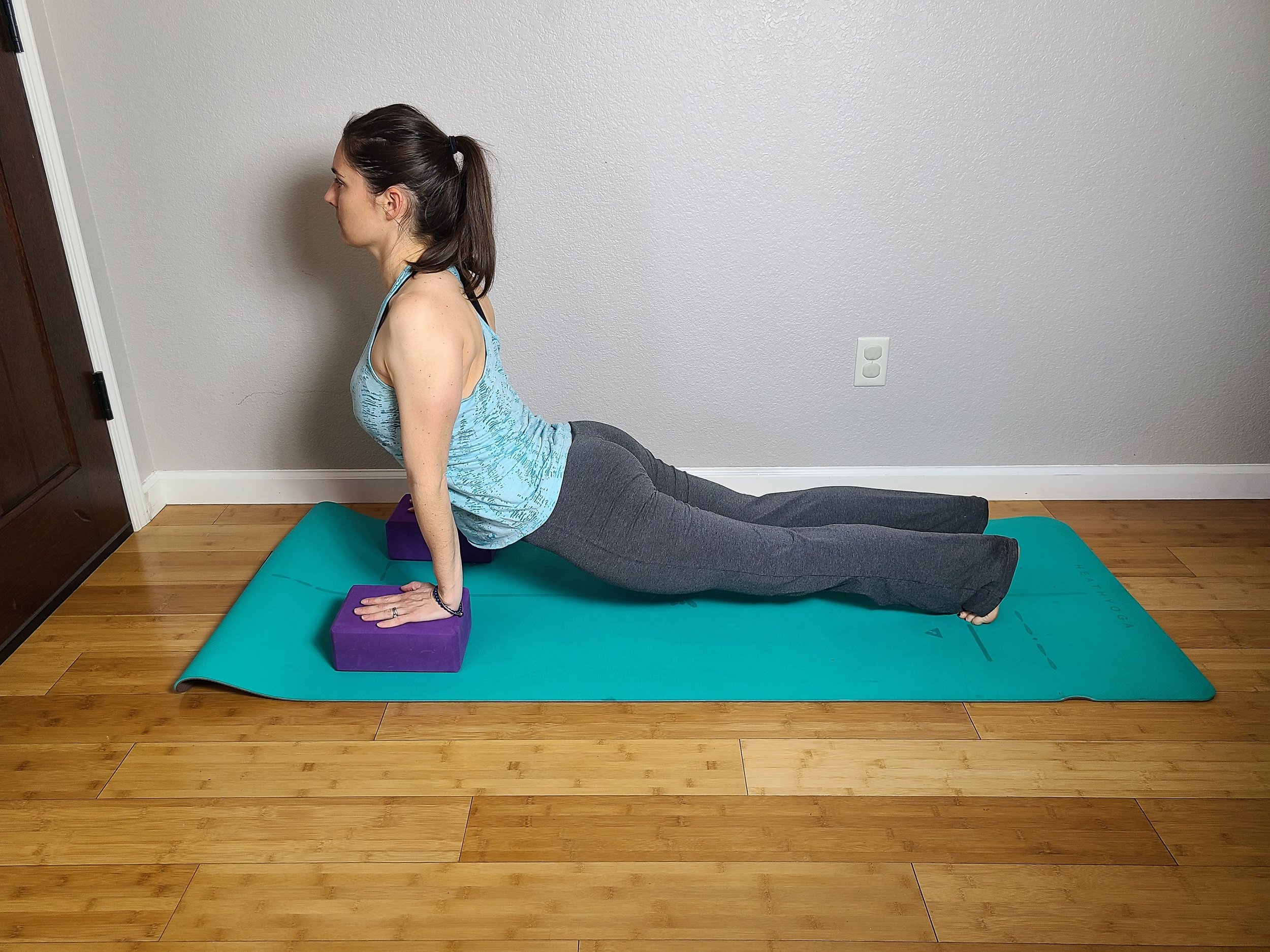Upward-Facing Dog Hurts My Back
/Upward-Facing Dog (Urdhva Mukha Svanasana) is a yoga pose used in sun salutations (Surya Namaskar) and vinyasa flows as a backbend that extends the spine, strengthens the muscles of the back and arms, and stretches the front of the chest and abdominals. It is a common pose, so why can’t I do it anymore? Why does it hurt?
This post breaks down this popular pose and why it may not work for everyone.
Typical instructions for how to do it:
1. Start in a prone position (lying face down), with your hands near your shoulders and your elbows pointing behind you.
2. Inhale and press your palms into the mat, lifting your chest and legs off the floor. Aim to straighten your arms and keep your elbows close to your body.
3. Roll your shoulders back and lift your chest up and forward while gazing ahead.
4. Press down into the tops of your feet and engage your upper thighs.
5. Hold the pose for a few breaths, then slowly lower to the mat.
Why is this pose painful for many people?
This pose requires several skeletal and muscular actions that can be problematic for many people.
Those with ankle, knee, hip, SI joint, spine, wrist, elbow, and shoulder pain or issues might find this pose uncomfortable or inaccessible.
Because the ankles are in plantar flexion as a foundation of the pose (bearing weight on the ground), Upward-Facing Dog can put too much load on the ankles. The knees are in extension, and if you have a hard time straightening your knees, this pose will be challenging. Your range of motion in your hips and SI joint will limit your ability to move and extend. The spine is in extension, and those with back pain, scoliosis, or disc issues may not be able to come to the full expression of Upward-Facing Dog. Similar to the ankles, the wrists are in extension and bearing a significant amount of body weight. The elbows and shoulder joints are also in extension and supporting the weight of the upper body. Specifically, the rotator cuffs are working to stabilize the shoulder joints, and if you have a rotator cuff injury you might have trouble with this pose.
In short, there are many places someone can find difficulty in Upward-Facing Dog. Make sure to check with your medical provider about the physical challenges you have and whether you are cleared to do yoga or practice this pose.
I have SI joint dysfunction and mild scoliosis, which make this pose challenging for me. I did Upward-Facing Dog every day ten years ago and now the pinching in my low back has made this pose a challenge for me and my body. As a result, I have transitioned away from many flow-based yoga classes. Regularly and quickly entering Upward-Facing Dog for transitions became too much for my body.
However, I still periodically do Upward-Facing Dog, and here are the ways that I have learned to adapt the pose for my body.
Lift up on the toes
Usually you see people do Upward-Facing Dog from the tops of their feet. However, this requires rolling over the foot in the transition from Low Plank (Chaturanga) in a sun salutation or flow. By staying up on your toes, you keep your thighs active, which supports your low back, can better stabilize your lower half, and allows you to slightly reduce the amount of back bending you want to do.
This is a good first option if you experience only a slight pinching in the lower back and are still regularly practicing flow-based yoga.
Use props to stabilize weak, unstable, or painful joints


There are several props you can use to make Upward-Facing Dog more comfortable or accessible. To better support your lower back, you can place a yoga block between your thighs or place a rolled blanket under your thighs. For additional shoulder or elbow support you can secure a strap around your arms just above your elbows (or on your elbows depending on who you talk to) and press out into the strap. You can also lift your hands up on blocks to help you find a little more opening in the front of your chest.
Do the pose with hands on a chair
You can do Upward-Facing Dog with your hands on the seat of a stable chair. You can still lift up through the front of the chest and extend through the spine, but the angle of spinal and hip extension will be less.
Use an alternative pose
Cobra pose
Alternative poses like Cobra (Bhujangasana), Locust (Salabhasana), and Sphinx (Salamba Bhujangasana) are prone back extensions that can offer many similar benefits to Upward-Facing Dog but less pain. However, as these poses are still strong back extensions, they should be used with your specific body in mind.
Work up to doing the pose
It is possible to work up to doing Upward-Facing Dog through the course of your yoga practice. Consider ways to warm up the spine, hips, and shoulders throughout a class in order to prepare for it—don’t just jump in. Often, by the end of a well-sequenced class I can spend a couple breaths in the pose safely without discomfort.





